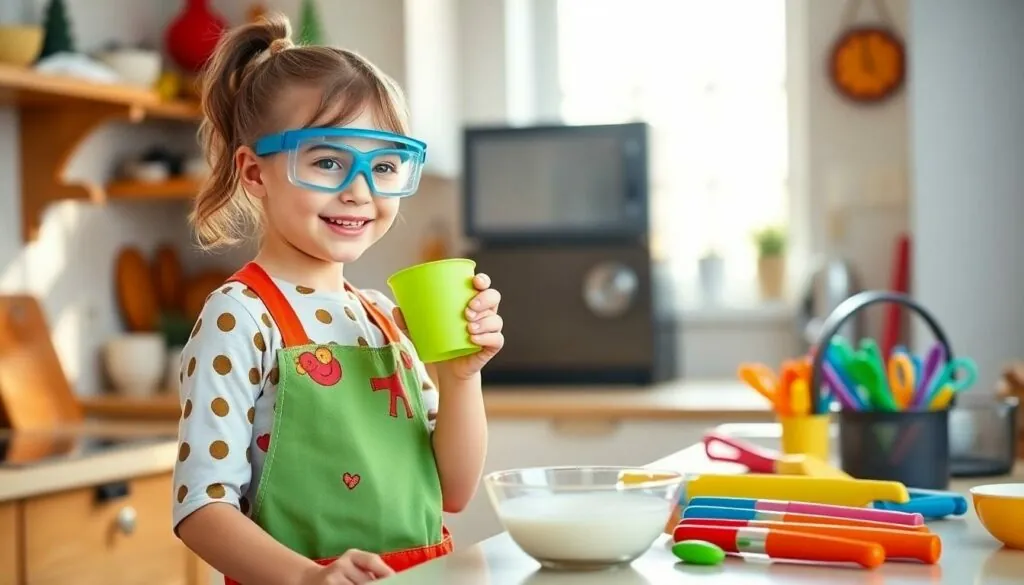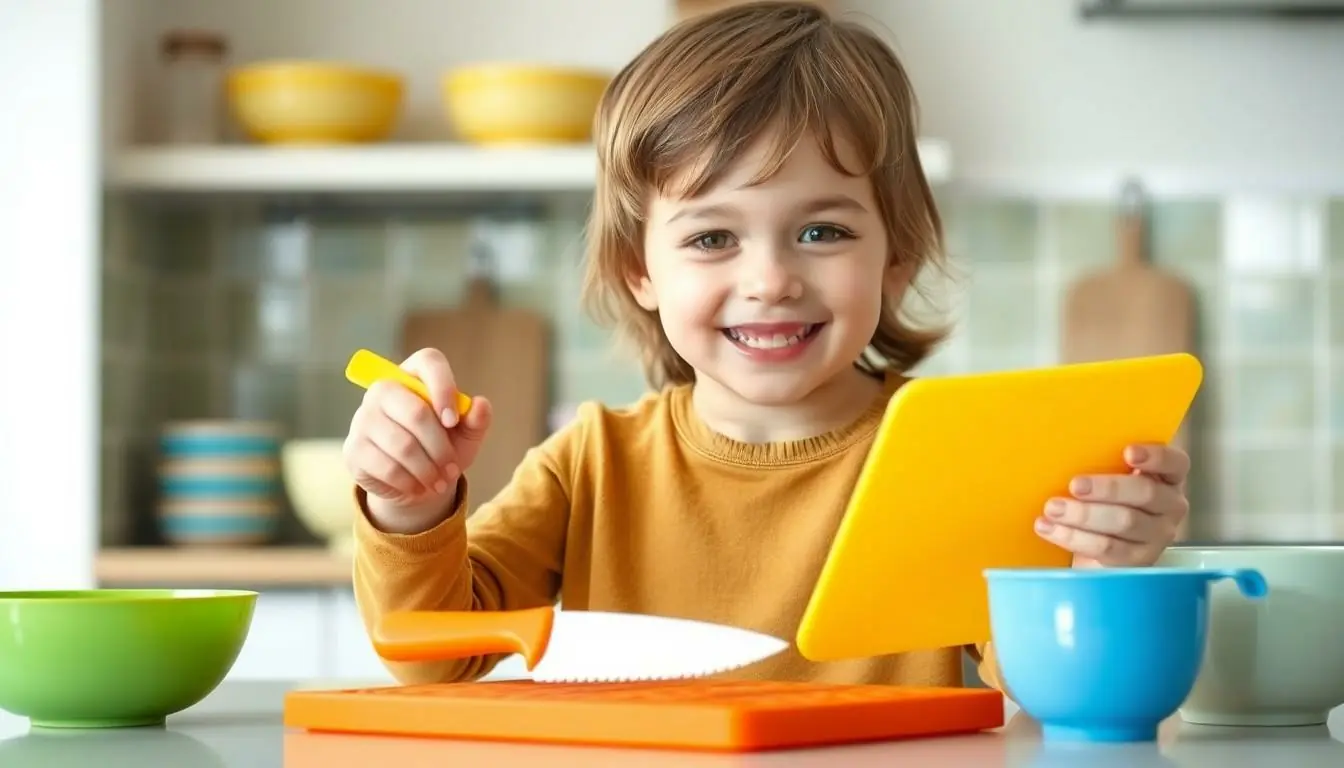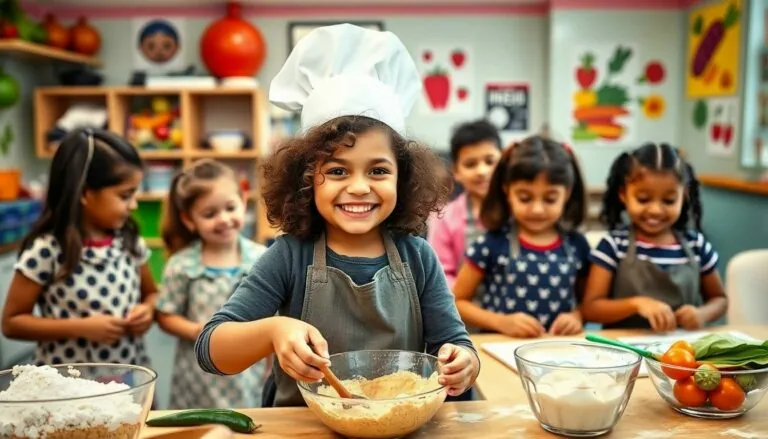Getting kids involved in the kitchen isn’t just about creating future master chefs – it’s about building confidence skills and making memories that’ll last a lifetime. But before letting little ones loose with pots and pans it’s essential to equip them with the right tools that are both safe and fun to use.
From colorful measuring cups to kid-friendly knives the market now offers an amazing array of cooking supplies designed specifically for budding young chefs. These tools aren’t just miniature versions of adult equipment – they’re thoughtfully crafted to help small hands gain independence in the kitchen while keeping safety as the top priority. Parents who invest in proper children’s cooking supplies often find their kids more eager to participate in meal prep and more likely to try new foods they’ve helped prepare.
Table of Contents
ToggleEssential Kitchen Safety Equipment for Kids
Safety equipment creates a secure cooking environment for children while building their confidence in the kitchen. The right protective gear minimizes risks while maximizing learning opportunities.
Protective Gear and Aprons
Child-sized cooking aprons protect clothes from spills while adding a professional touch to kitchen activities. Cotton aprons with adjustable neck straps fit kids aged 4-12 comfortably. Heat-resistant silicone gloves shield small hands from hot surfaces during baking tasks. Protective eyewear guards against food splashes when mixing ingredients or using electric appliances. Food-safe plastic hair nets keep loose strands away from food preparation areas. Many protective gear sets come in bright colors or fun patterns that make safety equipment appealing to young chefs.
Non-Slip Mats and Stools
Anti-slip kitchen mats provide stable footing near counters sink areas. Textured rubber mats measure 24×36 inches offering ample standing space for cooking activities. Kitchen step stools with non-skid surfaces elevate children safely to counter height. Double-step designs include safety rails allowing secure access to higher cabinets shelves. Cushioned standing mats reduce fatigue during longer cooking sessions. Portable lightweight stools fold easily for storage between cooking sessions. Grip strips on stool bases prevent movement on smooth floor surfaces.
Kid-Friendly Cooking Tools and Utensils
Specialized cooking tools enable children to participate safely in meal preparation while developing essential kitchen skills. These age-appropriate utensils feature ergonomic designs specifically crafted for small hands.
Plastic Knives and Cutting Boards
Plastic knives with serrated edges cut through soft foods like bananas, cucumbers or bread without risking injury. Colorful nylon knives include finger guards to protect small hands during chopping tasks. Lightweight cutting boards with non-slip bases provide stable surfaces for food preparation. BPA-free plastic boards featuring fun shapes or characters make cutting activities more engaging. These tools allow kids to practice proper knife skills while maintaining safety.
Measuring Cups and Spoons
Durable plastic measuring sets introduce children to kitchen math through hands-on portion control. Nested cups with large handles snap together for easy storage between uses. Color-coded measuring spoons help kids identify different quantities at a glance. Sets include standard measurements: 1 cup, 1⁄2 cup, 1⁄3 cup, 1⁄4 cup and 1⁄8 cup portions. Clear markings on each utensil reinforce number recognition skills during recipe preparation.
Mixing Bowls and Whisks
Lightweight mixing bowls with pour spouts minimize spills during ingredient combining. Non-skid rubber bases keep bowls stable on countertops during vigorous stirring. Mini whisks sized for small hands feature comfortable grip handles for extended mixing sessions. Silicone-coated wire whisks prevent scratching on non-stick cookware surfaces. Nesting bowl sets in graduated sizes store compactly while offering multiple options for different recipe needs.
Fun Baking Supplies for Young Chefs
Baking activities spark creativity in children while teaching them fundamental cooking skills. The right baking tools transform kitchen time into an engaging educational experience.
Cookie Cutters and Molds
Kid-friendly baking starts with durable plastic cookie cutters in various shapes including animals alphabet numbers geometric patterns. Silicone molds featuring cartoon characters superheroes seasonal themes create excitement for young bakers. Nonstick silicone bakeware enables easy release of finished treats reducing frustration during unmolding. Multi-sized cutters allow children to create layered designs or make coordinated sets of treats. Rolling cookie stamps with built-in patterns add texture without sharp edges. Mini tart pans cupcake molds cake pop makers sized for small hands encourage portion control while maintaining safety.
Decorating Tools and Sprinkles
Child-safe decorating tools include plastic piping bags reusable squeeze bottles rubber spatulas icing combs. Edible decorations feature natural food coloring sugar pearls chocolate chips crushed nuts colored sprinkles. Gel-based food colors provide vibrant results with minimal drops required. Decorating stencils guide precise pattern application on cakes cookies cupcakes. Easy-grip fondant tools roll smooth surfaces create textures cut shapes without sharp edges. Storage containers with pour spouts organize decorating supplies prevent spills maintain freshness. Writing bottles with different tip sizes enable controlled application of icing designs text messages decorative borders.
Educational Cooking Kits and Sets
Educational cooking kits combine learning with hands-on kitchen experiences. These specialized sets integrate math, science, and creativity while teaching children fundamental cooking skills.
Recipe Cards and Cookbooks
Kid-focused recipe cards feature step-by-step instructions with bright pictures enhancing comprehension. Large-print cookbooks display color-coded measurements alongside simple techniques for young chefs aged 4-12. Educational recipe collections incorporate math concepts through fraction-based measurements and timing exercises. Digital recipe apps offer interactive features including voice commands and video demonstrations. Popular options include:
- Picture-based recipe cards with 5-8 steps per recipe
- Wipe-clean cookbooks with water-resistant pages
- Math-focused recipe collections teaching fractions
- Interactive cooking apps with child-safe navigation
- Theme-based recipe sets (space food, world cuisine, garden recipes)
Cooking Activity Boxes
Monthly subscription boxes deliver age-appropriate cooking projects with pre-measured ingredients. Each box contains 3-4 themed recipes, cooking tools sized for children, and educational activity cards. Popular cooking box features include:
- Seasonal ingredient exploration boxes
- Cultural cooking kits teaching global cuisines
- Science-based food experiment sets
- Farm-to-table education boxes
- Baking projects with decorating supplies
| Age Group | Tools Included | Activities |
|---|---|---|
| 4-7 years | 5-7 basic tools | 2-3 simple recipes |
| 8-12 years | 8-10 tools | 3-4 complex recipes |
| Teens | 12-15 tools | 4-5 advanced projects |
Age-Appropriate Kitchen Equipment
Selecting kitchen equipment based on a child’s age ensures safe cooking experiences while developing essential culinary skills. Each age group requires specific tools that match their motor skills and cognitive development.
Toddler Tools (Ages 2-4)
Toddlers engage best with large, colorful kitchen tools designed for small hands. Silicone mixing spoons measure 8 inches long with soft grips that prevent slipping. Plastic measuring cups come in bright colors with easy-pour spouts. Rolling pins sized at 6 inches help little bakers work with play dough or soft cookie dough. Sturdy plastic bowls feature non-skid bottoms to prevent spills during stirring. Safety equipment includes child-sized aprons with adjustable neck straps, lightweight plastic mixing tools, and durable plastic cutting tools for soft foods like bananas or bread.
School-Age Supplies (Ages 5-12)
School-age children handle more advanced kitchen tools with proper supervision. Junior chef knives feature rounded tips and finger guards for enhanced safety. Heat-resistant spatulas extend 10 inches for controlled flipping. Measuring tools include digital scales with large displays and graduated measuring cups marked in both standard and metric units. Metal mixing bowls range from 1-3 quarts with rubber bases for stability. Food preparation tools encompass box graters with protective covers, whisks with ergonomic handles, and peelers designed for small hands. Storage containers feature snap-on lids that children can manage independently.
Conclusion
Cooking with kids is more than just a fun activity – it’s an investment in their future skills and confidence. The right cooking supplies can transform the kitchen into a safe learning environment where children develop independence and creativity.
From kid-friendly knives to educational cooking kits parents have numerous options to make cooking both safe and engaging for their little chefs. These age-appropriate tools paired with proper safety equipment create the perfect foundation for children to explore and experiment in the kitchen.
By choosing the right supplies parents can help their children develop essential life skills while creating lasting memories in the kitchen. It’s clear that investing in quality kid-focused cooking equipment is a recipe for culinary success.







